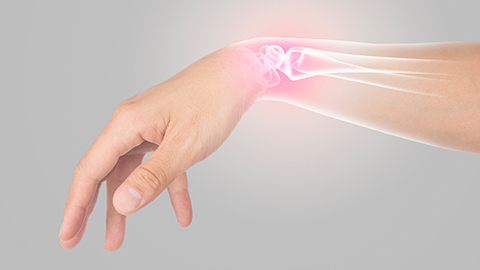
What happens when a bone that forms a major pivot point in the wrist falls apart? A friend of a massage therapist is looking for some self-massage ideas as she recovers from a pioneering surgery on her wrist to repair damage from a rare and painful condition called Kienböck’s disease. Or lunatomalacia. Or avascular necrosis of the lunate. Kienböck’s disease? What is it? And why does it lead to wrist reconstruction surgery? And will massage therapy make this worse?
Resources:
American Society for Surgery of the Hand. “Kienbock’s Disease.” Accessed June 11, 2021. www.assh.org/handcare/condition/kienbocks-disease.
Brazier, Yvette. “Kienböck’s Disease: What You Need to Know.” February 9, 2017. www.medicalnewstoday.com/articles/264720.
Divelbiss, Brian J. “Kienbock Disease.” Last modified September 27, 2019. https://emedicine.medscape.com/article/1241882-overview.
Jennings, Charles D. “Kienböck’s Disease.” Last modified May 2012. www.orthoinfo.org/en/diseases--conditions/kienbocks-disease.
National Organization for Rare Disorders. “Kienböck Disease.” Accessed June 11, 2021. https://rarediseases.org/rare-diseases/kienbock-disease.
Physiopedia. “Lunate.” Accessed June 11, 2021. www.physio-pedia.com/Lunate.
MedStar Health. “New Advanced Microsurgery Saves Wrist Function for Patients with Kienbock’s Disease Curtis National’s James Higgins, MD, Becomes First US Doctor to Perform Surgery.” July 15, 2016. www.medstarunionmemorial.org/2016/07/15/new-advanced-microsurgery-saves-wrist-function-patients-kienbocks-disease-curtis-nationals-james-higgins-md-becomes-first-us-doctor-perform-surgery.


This podcast sponsored by:
About Anatomy Trains:
Anatomy Trains is a global leader in online anatomy education and also provides in-classroom certification programs forstructuralintegration in the US, Canada, Australia, Europe, Japan, and China, as well as fresh-tissue cadaverdissectionlabs and weekend courses. The work of Anatomy Trains originated with founder Tom Myers, who mapped the human body into 13 myofascial meridians in his original book, currently in itsfourthedition and translated into 12 languages. The principles of Anatomy Trains are used by osteopaths,physicaltherapists,bodyworkers,massagetherapists,personaltrainers,yoga,Pilates,Gyrotonics,and other body-minded manual therapists and movement professionals. Anatomy Trains inspires these practitioners to work with holistic anatomy in treating system-wide patterns to provide improved client outcomes in terms of structure and function.
Website:anatomytrains.com
Email:info@anatomytrains.com
Facebook:facebook.com/AnatomyTrains
Instagram: instagram.com/anatomytrainsofficial
0:00:00.0 Speaker 1: Ruth Werner's best-selling book, A Massage Therapist's Guide to Pathology, is a highly-regarded comprehensive resource that sets the standard for pathology education. Written for massage therapy students and practitioners, this groundbreaking resource serves up a comprehensive review of the pathophysiology, signs, symptoms and treatment of more than 500 diseases and disorders. Learn more at booksofdiscovery.com.
0:00:32.4 Speaker 2: Anatomy Trains is happy to announce our return to the dissection lab in person, January 10th to the 14th, 2022 at the Laboratory of Anatomical Enlightenment in Boulder, Colorado. We are thrilled to be back in the lab with Anatomy Trains author Tom Myers and master dissector Todd Garcia. Join students from around the world and from all types of manual, movement and fitness professions to explore the real human form, not the images you get from books. This is an exclusive invitation. Email info@anatomytrains.com if you'd like to join us in the lab.
[music]
0:01:17.1 Ruth Werner: Hi, and welcome to "I Have A Client Who... " Pathology Conversations with Ruth Werner, the podcast where I will discuss your real-life stories about clients with conditions that are perplexing or confusing. I'm Ruth Werner, author of A Massage Therapist's Guide to Pathology, and I have spent decades studying, writing about, and teaching about where massage therapy intersects with diseases and conditions that might limit our client's health. We almost always have something good to offer even with our most challenged clients, but we need to figure out a way to do that safely, effectively and within our scope of practice, and sometimes as we have all learned, that is harder than it looks.
0:02:04.3 RW: This week's episode is about a person who is a friend of a massage therapist but not a client, at least not at this moment. The condition is rare, but I have known at least one massage therapist who had it. And here's a little trigger warning. This episode is about a hand injury. And I know that for me at least, since the first day I started massage school, any thought of hurting my hands of having arthritis in my hands or scraping my knuckles or fraying hangnails, or anything that might make it hard for me to do massage. Even though I don't do massage anymore, this all still makes me feel a little wriggly and uncomfortable. And this episode is a fine example of a hand injury. So if you're like me, and you get a little iffy when we talk about things that can happen to your hands, just be aware that this is what's on deck for today.
0:03:01.5 RW: And the story starts with this Facebook post. "Does anyone have experience working with someone who has Kienbock's disease, it's a condition where the blood supply to the lunate bone is cut off and it eventually dies. A friend had a lunate replacement constructed out of part of her knee last year, but still has significant pain in her wrist and forearm." I reached out to this person and asked if I could use this story in an I Have A Client Who podcast, and they contacted the person who has Kienbock's disease to make sure that she gave permission, which she did. So all of the involved parties have allowed me to share this. And it turns out that the person with the hand and wrist problem was looking for some good self-massage techniques to help her with her recovery, which is why it's a great match for I Have A Client Who.
0:03:53.2 RW: So what in the world is Kienbock's disease? It is a rare condition of questionable aetiology that results in a loss of blood flow to the lunate bone in the carpals. The lunate is in the middle of the proximal row of the carpal bones. When we flex and extend the wrist, the lunate is a leverage point. It has that name because it is vaguely crescent shaped, which reminded anatomists of the moon, luna in Latin. Here's a side note, you're probably aware that we have several other moon references in anatomical features, but they have ended up with the names derived from the Greek word for moon, mene, think meniscus which refers to the crescent shaped cartilage structures in our knees and our jaws. I bet you can think of a couple of other moonish human features that come from the word root "mene" too. But back to the lunate. This bone articulates with the radius but also the triquetrum, the capitate, the hamate, and the scaphoid bones. It's held in place by ligaments and it helps to provide support and mobility in the proximal hand.
0:05:03.6 RW: Sometimes, for reasons that are not always clear, the lunate bone loses its blood supply and it degenerates. Because it is in such a crucial position right there in the center of the wrist, problems here can cause secondary damage to neighbouring bones, and this is what we call Kienbock's disease, even though Kienbock, who was not the first person to report it, but he was an early radiologist who studied it, suggested a more lyrical name, he wanted to call it lunatomalacia, softening of the lunate, and all this happened in the early 1900s. Since then, a couple of other names have been proposed osteonecrosis of the lunate. You can hear what that means, osteo, bone tissue, and necrosis, death. And avascular necrosis of the lunate. That label is clear too, death of tissue because of lack of blood flow.
0:05:58.3 RW: Interestingly, there's another place avascular necrosis happens and that is in the head of the femur. But in the reading I did about Kienbock's disease, I did not see any associations between these two conditions. This condition, Kienbock's disease, is progressive. It gets worse over time. It may be brought about by a structural anomaly in the shape of the lunate bone or by a variation in blood supply to the bone. Some people have two blood vessels going into the bone, some people only have one. It can arise out of a single wrist injury. My friend developed this after a wrist injury in a car accident. Or it has been seen as a cumulative issue after multiple smaller injuries. It can have to do with the shape of other bones as well, especially the ulna and the capitate. We see Kienbock's disease most often in the dominant hand of men between 20 and 40 years old, which makes today's person a little unusual.
0:06:58.9 RW: In early stages of Kienbock's disease, counterintuitively to what we might predict, the bone appears to become denser. And we can see this in X-rays and also CAT scans and MRIs. Later, this density is then followed by degeneration, fracturing, and collapse. One of the tricky things about Kienbock's disease is that it can be hard to distinguish it from a handful of other wrist issues. [chuckle] A handful of wrist issues, I crack myself up. Depending on how far advanced it is, Kienbock's disease can look like a bad sprain, maybe with a minor fracture, or carpal tunnel syndrome, or a condition called Sudeck's atrophy. This one is also called post-traumatic osteoporosis. So think about that for a second. This is an acute and sudden onset and severe atrophy of the bones after a wrist injury, but it isn't limited to just the lunate. If this is identified really early than rest with a splint or a cast might help to restore good blood flow to the lunate. But this doesn't seem to be a typical pattern, and at this point, surgery appears to be the best option for many patients.
0:08:19.2 RW: A lot of research has been done to determine the best surgical strategy for different ways this condition affects the hand bones. A surgery can replace the damaged lunate with another piece of bone, which was the strategy for the person in today's story, or it could be done to lengthen the ulna, or to shorten the radius, or to fuse some of the carpal bones. You can imagine the aftermath of any of these procedures and the prospect for the return of hand and wrist mobility. It's not likely to return to full function. So let's talk again about the person who started this whole conversation. She invited me to contact her and she shared a little more information about her situation. She's an artist, a painter, and she'd had increasing pain and limitation in her hand and wrist for a number of years. Finally, she had a surgery in which a piece of bone from her knee was inserted into her wrist, and this was carried over with cartilage and blood supply to make sure that that new tissue doesn't degenerate.
0:09:24.3 RW: I found an article about her surgeon and this pioneering technique, and I will share that in the show notes. The surgery generally has a good outcome, but range of motion is likely always to be limited. I know this patient uses her hands and her fine motor skills in her work and she told me that she has become more adept with her left hand, so welcome to the left handers club. But returning to best function is really important to her. Are there any specific self-massage techniques that she should look for or that she should avoid? And what if she ever visits a massage therapist, what should that person be doing for her? Well, I have some pretty good news, which is that pretty much, always within pain tolerance and with great respect for a range of motion that is limited by the shape of her bones, anything goes with manual therapies. I'd love her to find a massage therapist who can show her some gorgeous stretches, maybe pin and stretch self-massage for her flexors and extensors because remember, she's still having a lot of forearm pain.
0:10:27.7 RW: My hope is that her physical therapist taught her some good exercises to keep her thumb and fingers as strong and flexible as possible. And a massage therapist can build from that foundation to help her establish and to keep healthy tissues. As far as we know, this condition is related to the shape of bones and the nature of blood supply. It's not metabolic, it's not related to systemic problems. And all that means is that as long as we're careful about the boundaries set by surgery, massage therapy will be safe and fine and might even be helpful to promote the best outcomes possible.
0:11:06.4 RW: Hey everybody, thanks for listening to I Have A Client Who Pathology Conversations with Ruth Werner. Remember, you can send me your I Have A Client Who stories to ihaveaclientwho@abmp.com. That's ihaveaclientwho, all one word, all lowercase, @abmp.com. I can't wait to see what you send me, and I'll see you next time.